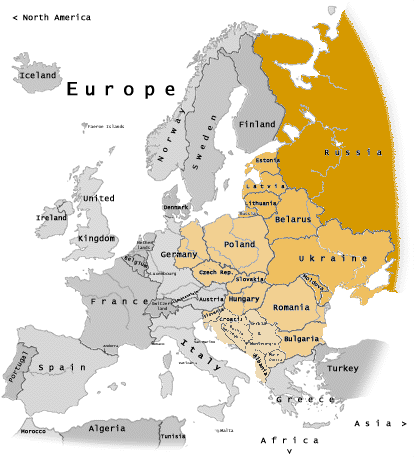Central and Eastern Europe
Eastern Europe, also known as Eastern Europe, is the eastern region of Europe with a particularly complex ethnic composition and a wide variety of cultures and religions.

Hungary, the Czech Republic, Slovakia and Poland, also known as Central and Eastern Europe, are among the countries mentioned in the article “The countries that didn’t make it to the road – Hungary“.
From the Middle Ages to the modern period, these countries were part of a federation of dynasties or confederacies (between Hungary, Bohemia, Poland and Lithuania) and were part of Germanic countries such as the Holy Roman Empire and the Austrian Empire. From the end of the Holy Roman Empire and the Austrian Empire to after its collapse, it was the centre of the pan-Slavist movement, which sought freedom from the Empire and solidarity among Slavs (whereas the Republic of Poland and Lithuania advocated multi-ethnic coexistence). In both World Wars, Poland was the scene of conflict between Germany, the Russian Empire and the Soviet Union, and after the war it became a satellite state of the Soviet Union as an eastern country of Soviet-style socialism. Since the end of the Cold War, Hungary has been politically aligned with the West and is a member of NATO and the European Union. Note that, with the exception of Hungary, the majority of the country’s population is of Slavic ethnicity.
Central and Eastern Europe and art
Central and Eastern Europe (Central and Eastern Europe) is also a region with a rich artistic tradition reflecting such a complex history and diverse cultural background. The art scene in Central and Eastern Europe has been deeply influenced by historical, social and political transitions, and is marked by a diversity of styles and expressions.
In terms of historical context, Central and Eastern European art has been influenced by many cultural influences from ancient times to the present day, with the art of each country reflecting these historical backgrounds through periods of Ottoman, Habsburg and Soviet Union rule.
In addition, contemporary art in Central and Eastern Europe has been particularly active since the fall of communism. New art scenes have emerged in many countries, with an increasing number of works exploring contemporary issues and social themes, and a number of competing art festivals, such as the Brno Biennale, Warsaw Biennale and Trnava Triennale, have been held, as mentioned in the Setouchi International Art Festival.

Graphic design and posters from Eastern Europe.
Graphic design and poster art have developed as an important art form in Central and Eastern Europe with its own unique characteristics. It has been sublimated as an art form with many social, political and cultural influences through the following historical trends in the 20th century.



First, with regard to the interwar period after the Russian Revolution (1918-1939), constructivism, in which “to know is to construct meaning in oneself”, spread throughout Central and Eastern Europe, and was particularly influential in Poland, Czechoslovakia and Hungary, where posters were an important tool for the spread of the new socialist system They became an important tool for spreading the new socialist regime. Furthermore, avant-garde design movements such as the German Bauhaus and the Dutch De Stijl, discussed in “On the common beauty of art and programming“, also influenced Central and Eastern Europe, and their emphasis on functionalism and simple design led to new trends in poster art and typography. These movements emphasised functionalism and simplicity of design, and brought about new trends in poster art and typography.
After the Second World War (1945-1989), under the influence of the Soviet Union, many Central and Eastern European countries adopted a socialist realist style, with an emphasis on posters as political propaganda, and posters from this period increasingly emphasised heroic workers and national successes, and from the 1950s to 1970s, Poland developed its own poster art movement, and these posters were internationally acclaimed for their simplicity, symbolism and artistic expression.
Throughout this history, graphic design and posters in Central and Eastern Europe became an important means of expressing the cultural identity of each country, especially posters promoting cultural events such as film, theatre and music, which reflected the country’s specific style and humour.
Moreover, posters as political propaganda played an important role, especially during the socialist period, and were displayed throughout the cities as a tool for spreading government ideology. On the other hand, some artists also used posters to convey anti-establishment messages, notably in the Polish ‘Solidarity’ movement of the 1980s, where underground publications and original posters played an important role.
Representative artists include Henrik Tomaszewski, a pioneering Polish graphic designer whose warm hiseha has an innocent beauty

Jan Leirich, Czech Republic, who uses many heart motifs and collages.

Hungarian Oros István humourously depicts the backs and fronts of the times in his elaborate deceptive paintings.

Karel Tyge from the Czech Republic, who specialises in poetry and dance visuals.

Jan Lenica, Poland, expressing a pulsating life force.

Ladislav Stunar from the Czech Republic, who specialises in designs that make use of pictograms.

Kászák Lajos, a representative of Hungarian constructivism.

They include Dushan Yunek, who beautifully portrays intellectual parodies.

Thus, Eastern European posters are characterised by high-impact designs with bright colours and bold compositions, while integrating text as a visual element through the shape and placement of letters.
In addition, contemporary Central and Eastern European graphic design and poster art are also actively combining approaches with digital technology, as described in ‘Generative art and programmes and algorithms‘. Designers are reaching out to global audiences through the internet, embracing new styles and technologies, and seeking their own expression by combining traditional elements with contemporary techniques and visual language.



コメント